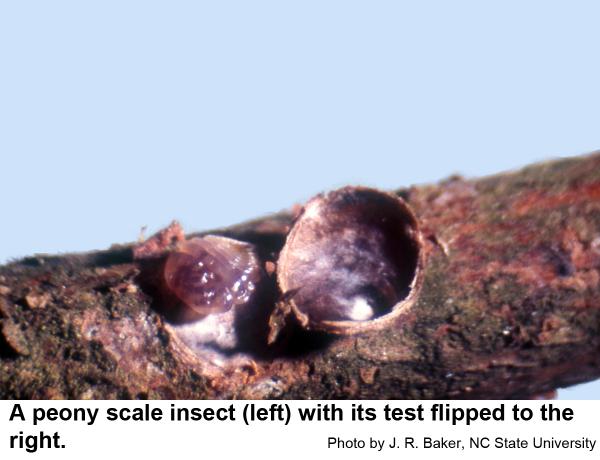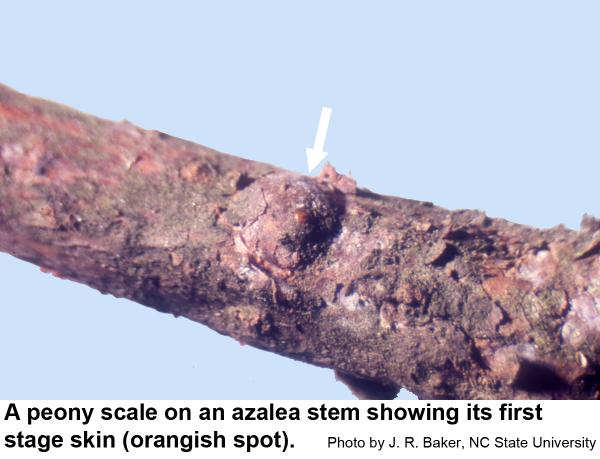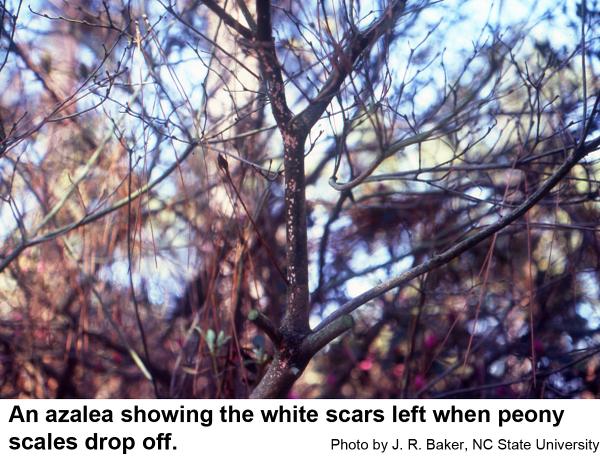Description and Biology
The peony scale, Pseudaonidia paeoniae, is a small, purple, circular or oval (about 3/32 inch in diameter), convex insect completely covered by a grayish-brown armor. This scale has a burrowing habit that at times becomes almost completely hidden by the bark. One of the more obvious signs of the peony scale is the lower portion of the armor which adheres to the stems of infested plants long after the upper armor and body of the insect has fallen away. The lower portion of the armor is circular and white (1/8 inch in diameter) whereas the upper armor of the live scale blends in almost completely with the bark. Females lay their eggs inside the armor, and newly hatched nymphs (crawlers) are tiny, flat, and purple. Crawlers usually emerge from under their dead mother's armor in May.
Host Plants
In North Carolina, the principal host plants of peony scale are azalea and camellia. It also infests dogwood, holly and rhododendron. Peony scale can be quite damaging to its host plants. Infested plants are often stunted and have noticeable dieback.
Residential Recommendations
Because the peony scale is an armored scale, one of the best chemical treatments for control is to spray an emulsion of 2% horticultural oil and 98% water (5 tablespoons per gallon of water). When plants are completely dormant in winter, 10 tablespoons of oil per gallon of water can be used. Either treatment should be repeated in about two weeks.
Other Resources
- Armored Scale Identification and Management on Ornamental Plants. Frank, S. 2010. Entomology Insect Notes, NC State Extension publication.
- Florida Armored Scale Insects. Dekle, G. W. 1965. Arthropods of Florida and Neighboring Land Areas, Vol 3. 265 pp.
- Horticultural Oils for Ornamental Plants. Frank, S. et al. 2018. Entomology Insect Notes, NC State Extension Publications.
- Insect and Related Pests of Shrubs. Baker, J. R. ed. 1980. NC State Extension publication. AG-189. 199 pp.
- NC State Extension Plant Pathology Publications
- Horticultural Science Publications
- North Carolina Agricultural Chemicals Manual
For assistance with a specific problem, contact your local N.C. Cooperative Extension center.
This factsheet has not been peer reviewed.
Publication date: Feb. 13, 2019
Revised: Nov. 30, 2023
Recommendations for the use of agricultural chemicals are included in this publication as a convenience to the reader. The use of brand names and any mention or listing of commercial products or services in this publication does not imply endorsement by NC State University or N.C. A&T State University nor discrimination against similar products or services not mentioned. Individuals who use agricultural chemicals are responsible for ensuring that the intended use complies with current regulations and conforms to the product label. Be sure to obtain current information about usage regulations and examine a current product label before applying any chemical. For assistance, contact your local N.C. Cooperative Extension county center.
N.C. Cooperative Extension prohibits discrimination and harassment regardless of age, color, disability, family and marital status, gender identity, national origin, political beliefs, race, religion, sex (including pregnancy), sexual orientation and veteran status.



